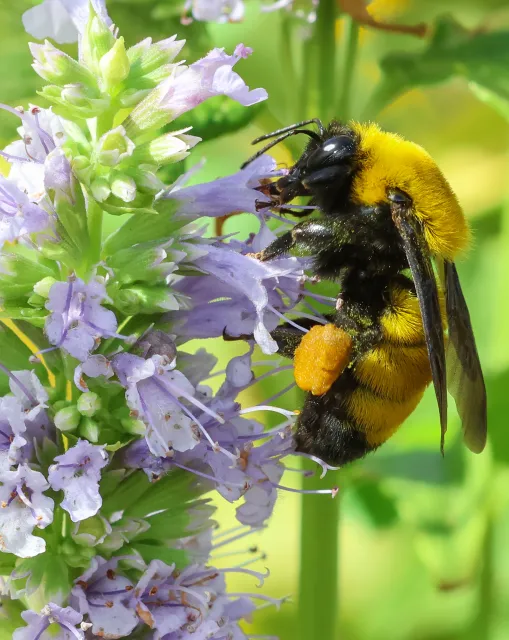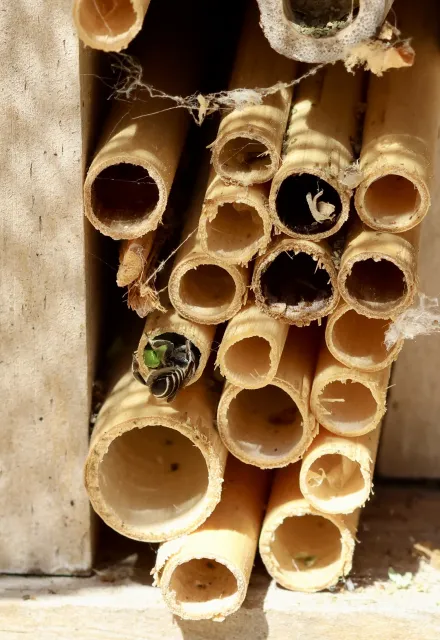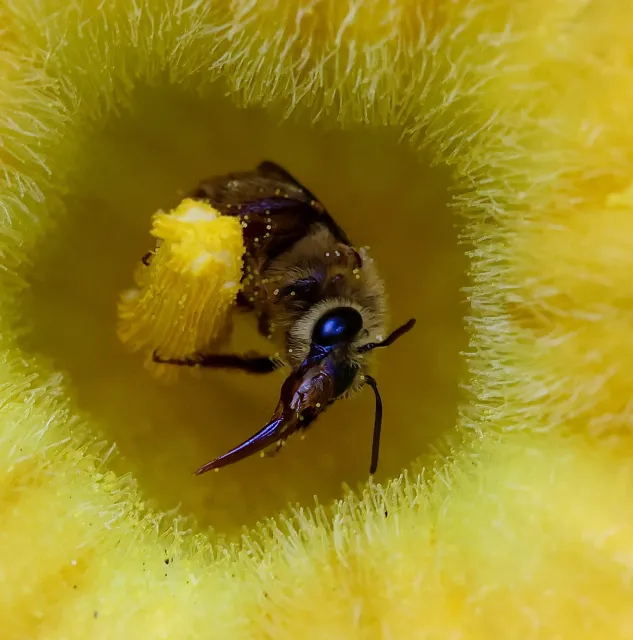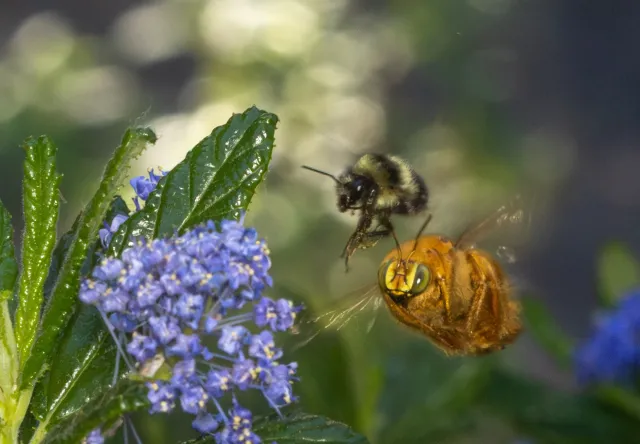National Pollinator Week
By Michelle Graydon
In 2007, the United States Senate unanimously approved a resolution designating a week in June as "National Pollinator Week" (this year it is June 23-29, 2025). In response to the alarm raised by an annual increase in commercial honey bee deaths in the US, the government and researchers began addressing the impact of pollinators on healthy ecosystems, crop production and the economy. Campaigns to “save the bees” were launched and many people around the world became aware of declining bee populations. From this beginning evolved a more complete understanding of the work done by different species of bees, and a more informed focus on which bees actually need saving. In fact, it is the thousands of native bee species that are experiencing rapid population losses, while honey bees, although under many pressures, are not declining worldwide.
Pollinator Partnership, a non-profit organization, was tasked with managing and popularizing Pollinator Week. Their efforts have been joined by a number of other organizations, including the Xerces Society for Invertebrate Conservation. Celebrating pollinators, raising awareness of their importance, and promoting their protection are the primary goals of all these conservation programs.

The general category of pollinators includes birds, moths, butterflies, flies, beetles, and wasps, as well as bees, but it is bees that are the best movers of pollen from flower to flower, leading to fruit and seed formation. This is because bees have branched hairs that pollen readily sticks to and they intentionally collect pollen for their young.
Although the effort to raise awareness about our native bees in California has been steadily successful, there are still many misconceptions about which bees are actually natives.
When you ask someone to describe a bee, they will often describe the honey bee (Apis mellifera). Introduced to the Americas for wax (and later honey) in the 1600’s, honey bees are now well established as both a commercial and a wild (or feral) insect. Because they are not native and are flower generalists, taking pollen and nectar from a wide variety of plants, they compete with the more than 1600 native bee species found in California alone and the over 4000 species throughout the US.
So which bees are native bees, especially the ones we are likely to see in our gardens and urban settings? The Urban California Native Bee Survey conducted by UC Berkeley’s Urban Bee Lab from 2005 to 2017 found that close to 400 species or 25% of the bees native to our state frequent city landscapes. These include six of the seven bee families found worldwide. Many native bee species are now more likely to be raised and supported for agricultural pollination: these include bumble bees, leafcutter bees, the blue orchard or mason bee, the alkali bee and the squash bee. All, with the exception of the alkali bee, can be found in our local backyards.
Bumble bees belong to a large family of bees called Apidae. They are charismatic, large, fuzzy bees with black, yellow and red or white markings. There are 25 species in California and more than twelve of these species can be spotted in Northern California counties. They are often confused with another large, dark native bee, the carpenter bee.
Bumble bees are declining nationally from loss of habitat, floral competition and introduced diseases and four species have been listed as endangered in California. Supporting them in your own garden by planting mostly native flowering trees and plants that bloom from early spring to fall can help build back their populations. Eliminating or greatly reducing the use of pesticides is also critical, as it is for all bees, and pollinators in general.

Bumble bees are considered generalist flower visitors. They readily take pollen and nectar from a wide variety of plants, especially species native to our area. Important plants likely to attract them are California lilacs (ceanothus), phacelia also known as scorpionweed), and many types of salvias. Bumble bees nest mostly in the ground and, although their nests can be large, the colony dies off in the fall with the exception of the next year's foundress or queen.
They are unlikely to bother anyone that doesn’t disturb them and are fascinating to watch as they go about their daily lives.
Leafcutter bees (in the family Megachilidae) are another of our garden residents that not only pollinate flowers and vegetables, but are managed in large groups to aid in the pollination of commercial crops, especially alfalfa. They are easy to provide for and will visit a variety of flowers. They need soft leaves that they cut with their large jaws and carry back to form their nest cocoons. They are solitary bees; the males die after mating and all the work of raising the next generation is done by a lone female.
About 78% of all native bees worldwide are solitary, and do not form communal nests or hives. Many of them nest in the ground, but some will create nests from twigs, holes in wood, or plant stems. Providing nesting areas is important for the success of all bees; you can help leafcutters in particular by setting out tubes made of natural material like reeds with a hollow diameter of about one-quarter inch, closed at one end, in a protected spot.
All bees in the leafcutter family are attracted to blooms in the sunflower family (Asteraceae) and readily visit cosmos, gumweeds, sunflowers and similar plants. Redbud trees, roses, and other plants with soft leaves are favored for making their cocoons, in which they will lay a single egg on top of a ball of collected pollen and nectar. Like many solitary bees, once the leafcutter female has provisioned her nest and laid her eggs she will die and the larvae will develop on the food she has left for them. They then metamorphosize into adults and emerge the following spring.

Another native pollinator residing in our gardens is the squash bee, or Epimelissodes (Peponapis) pruinosa. These bees in the Apidae family evolved from South America alongside wild squash plants. They are important pollinators of squash flowers, so if you plant pumpkins, butternut, or many other cucurbits you will likely have squash bees in your vegetable patch. They can be mistaken for honey bees because they look similar, but can be identified by their habit of rising very early, gathering pollen and nectar for their ground nests in the morning, and then sleeping for the rest of the day and night. Males are often seen sleeping inside closed squash blooms.
Although they are not used for commercial crop production, our native carpenter bees are a crucial pollinator and vital to biodiversity and ecosystem health. They are often misunderstood and maligned as pests that cause damage to wooden structures. Although this does happen, it is fairly easy to dissuade them from building a nest where you don’t want them without resorting to killing them. There are many sustainable and humane alternatives you can find online. In most cases carpenter bees are burrowing into unpainted or untreated softwood. Providing them with alternative nesting sites (an old log is great!), sealing up cracks, and painting wood is usually enough to control them near your home. Their contribution to pollination in your gardens and fruit trees far outweighs what is most often minor damage.
Another member of the Apidae family of bees, carpenter bees are the largest bees we have in California. They are distinguished from bumble bees by their shiny, hairless abdomens and smoky wings. One species, our valley carpenter bee male, is a beautiful fuzzy golden colored bee with green eyes known as the teddy bear bee. Like all male bees, they cannot sting; this is because the stingers in bees evolved from the female egg laying apparatus.

Teddy bear bees are fairly common in our gardens, often seen patrolling for females. They might fly near you, but remember that male bees cannot sting, and almost no solitary female bee (or wasp for that matter) wants to sting or attack unless they are defending themselves. Social bees and wasps (the cousin that bees evolved from) do defend their hives and nests, often aggressively if you're not careful around them.
Pollinator Week is a great opportunity to learn more about native bees and all the important pollinators in our community, including our native wasps, butterflies, flies, beetles and birds. The most vital steps to take at home and in our community are ensuring that our gardens have plants (especially natives) with blooms that are attractive to bees and other pollinators; eliminating or reducing pesticide use; and providing nesting areas for both stem-dwelling and ground-nesting bees.
Remember: If you plant them, they will come!
UC Master Gardeners of Butte County are part of the University of California Cooperative Extension (UCCE) system. To learn more about us and our upcoming events, and for help with gardening in our area visit our website. If you have a gardening question or problem, email the Hotline at mgbutte@ucanr.edu or leave a phone message on our Hotline at 530-552-5812. To speak to a Master Gardener about a gardening issue, or to drop by the MG office during Hotline hours, see the most current information on our Ask Us section of our website.
